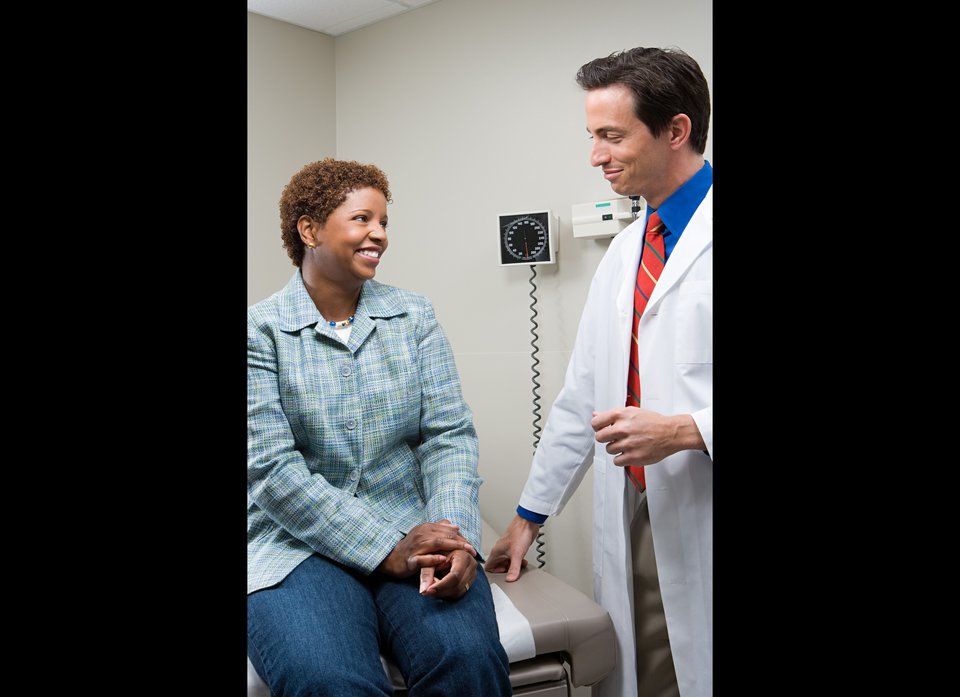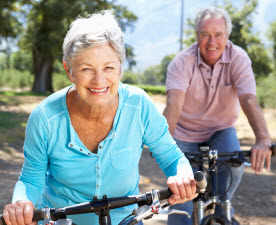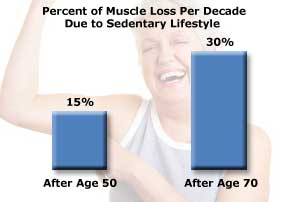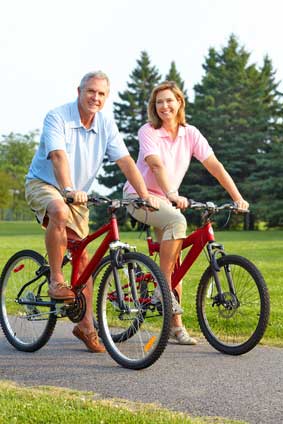
Exercise can enhance your energy levels, keep you at a healthy weight, and even possibly reduce some of the symptoms associated with aging. Exercise can be good for your brain and emotional state as well as your body. Whether you’re looking to maintain your current weight or to feel more energetic and healthy overall, there are numerous ways to stay active when you’re over 50.
We recommend that you speak with your health practitioner prior to starting any new exercise routine or making changes to your current one.
A FEW GOOD REASONS
TO STAY ACTIVE
There are many benefits to staying active at any age, but for those
over 50, being physically active could bring about many
advantages that enhance your quality of life.
Here’s what some experts we contacted had to say:
- “The most important benefit for seniors from exercise is that it can add years to your life, but it will also most certainly add life to your years.”Paula Todd, Registered Fitness Trainer & Older Adult Specialist, The Fitness Network
- “The more muscle mass that you have as you age, the more it will fight off a wiggly jiggly body caused by sarcopenia – muscle loss that comes when you don’t keep your muscles fit and firm. I am at 50 and living proof that if you lift weights, stretch and eat organic food you can stay fit, firm and fabulous forever!”Annette Spanski, Creator of Keep Life Simple 12 week Anti-ageing Program
- “Healthy bones are essential to live a fit active healthy lifestyle. Bone health is an issue that you may not even think about until you actually have a fall and fracture a bone. Statistics show that poor bone health affects over 6.3 million Australians and this can lead to bone fractures which in turn can cause chronic pain, disability or loss of independence… It is really important to take some action daily to build and maintain your bones.”Donna Emerson, Personal Fitness Trainer specialising in Group Fitness & Strength training for women 50+, Design Fit50
There are plenty more benefits too, which we go into below.
Increased energy levels and strength
Exercise can build muscle and bone mass,1 boost cardiovascular health,2 increase your energy levels and make you feel stronger.3
Prevent illnesses and diseases
Regular exercise has been linked to a reduced risk or delayed development of many illnesses and diseases, as well as providing benefits for those with chronic conditions, including:
- Heart disease and stroke2
- Joint and muscle pain1
- Type 2 diabetes5
- Alzheimer’s5
- Lung cancer5
- Colon cancer5
- Osteoporosis6
- Arthritis7
- High blood pressure7
- Breast cancer8
- Cholesterol8
Studies found that those who are fit are more likely to live longer and delay the onset of illnesses, with the most aerobically fit people typically developing chronic conditions in only the last five years of their life rather than the last 10, 15, or 20 years.5
Minimise the symptoms of chronic conditions
Exercise can help with some of the symptoms of chronic conditions or conditions associated with ageing. These include:
- Menopause symptoms9
- Joint pain9
- Weight gain9
- Lowered immune function3
- Poor digestion3
Stay independent
Exercise enhances your strength and flexibility, which supports better coordination and balance. By being physically fit, you could stay mobile and independent for longer.3
Quality of life
By reducing the risk of diseases, minimising the symptoms of chronic conditions, and retaining your independence, you’re more likely to experience a good quality of life and live life to the fullest.
Boost brain and emotional health
Exercise is well known for having a positive impact on stress levels by boosting mood and raising the level of endorphins in your body. It’s also good for your brain because it is associated with reducing the risk of memory loss, dementia, cognitive decline,3 and depression.11
Improve quality of sleep
Exercise may even improve the quality of your sleep. One study found that,
by doing just 150 minutes of moderate to vigorous activity per week, you can boost your sleep quality by as much as 65 percent.12
Maintain a healthy weight range
As your metabolism slows with age, staying fit and active helps you maintain a healthy weight range, which is conducive to better health and linked with a lowered risk of developing chronic health issues.13
TIPS FOR EXERCISING IN YOUR 50S AND BEYOND
Clearly there are many health benefits when it comes to exercising, but keep in mind that what you do and how long you do it for is also important.
We asked some fitness experts to share their tips on exercising over 50.
Here’s what they had to say:
- “The best piece of advice I tell my client base (which is 30–70’s) is find something you like to do for exercise. Your intention is important and that intention should be to do something that makes you feel good and have more energy. There are so many options – I love my Gyrotonic, Gyrokinesis, Pilates, Yoga and also love getting out on my bike and riding for 60 kilometers on a beautiful day or just taking a walk along the bay. Do something that makes you feel good and enjoy it!”Dana Rader, Accredited Exercise Physiologist, Gyrotonic Melbourne
- “To remain fit, we should all exercise every day, in as many ways as possible. Walking 15 or 20 minutes daily is the very minimum, but for optimum fitness, walking needs to be complemented with regular strength training, balance and stability exercises and stretching and mobility work. Find a form of exercise that you love and do it with a partner or friend… You won’t find it a chore if you enjoy yourself, and you may actually find yourself looking forward to your exercise sessions.”Paula Todd, Registered Fitness Trainer & Older Adult Specialist, The Fitness Network
- “Make exercise a part of your day – select the same time and days during your week so you don’t forget and it fits in with the rest of your week. It doesn’t have to be ‘slow and gentle’ – each client is an individual so work as hard as you can. Do it with friends and include cardio and resistance training.”Rob Hadley, National Master Coach, Australian Institute of Fitness
- “Be active everyday, focus on moving more and sitting less by keeping track of your steps each day. Incorporate some form of resistance training twice a week to protect your bone health and maintain your strength. Try doing some balance exercises everyday. Stand on one leg while waiting for the microwave to go off. Include some core stability exercises such as pilates or yoga to improve flexibility, address past injuries and reduce back pain. Start small and gradually build up into a regular routine. Look for group exercise classes to make things fun and social. Seek out the help of an exercise physiologist for expert advice.”Anna-Louise Moule, Exercise Physiologist specialising in working with people over 50, Balanced Bodies Lifestyle Clinic
- “Whether we are talking about nutrition, staying fit, losing weight, mental health, social wellness or anything related to the overall health and wellness of a human being, I have found one thing to be indisputably true – we are all completely unique. Each and every one of us is singularly unique due to a combination of our genetics and our environment (epigenetics). Because of this, we all age in different ways and have different health and wellness needs past the age of 50. Therefore general health advice simply can’t apply to everyone… Figure out what works for you. An exercise plan, a specific diet, or particular creative outlet may be doing wonders for your friend, partner, or cousin. But you are not them, and what works for them may not work for you. Listen to your body, educate yourself, figure out what’s best for you.”Matt Riemann, personalised health expert and CEO, ph360
- “You are never too young or too old to act to protect your bones. If you are doing nothing at all, you will be losing bone mass. The same kind of exercises are effective for bones at any age, but the difference will be your capacity level. You will start slow at a level you are capable and comfortable doing and increase the intensity as you grow stronger. The level at which you start will also depend on your health.”Donna Emerson, Personal Fitness Trainer specialising in Group Fitness & Strength training for women 50+, Design Fit50
- “One of the biggest misconceptions out there is that as we age we can’t do the things we did when we were younger. However, there are thousands of people out there proving this theory wrong every day. One of the biggest factors that causes us to deteriorate as we age is a sedentary lifestyle and quitting the healthy activities we did in our youth. There are people in their 70s, 80s and beyond still competing in competitive sport, so the limitations we have are the ones we impose on ourselves – simple as that.”Sam Theyers, Head of Fitness, Anytime Fitness
It’s never too late
Many people starting out with exercise in middle age are discouraged because they think it’s probably too late to reap real benefits. In fact, the opposite is true. Studies show that it’s never too late to start realising benefits from exercise. One particular study showed wheelchair-bound nursing home residents in their 80s and 90s experiencing benefits like improvements in their strength and overall functional ability from a weight-lifting exercise program.1
Some fitness experts say it’s even possible to get into the best shape of your life after the age of fifty if you’ve spent most of your life out of shape.1
Keep a regular routine
There’s no fixed formula for how much exercise you should do, as it depends on your current level of fitness and health, your fitness goals, and whether you have any health conditions. Generally speaking, however,
150 minutes of moderate aerobic activity or 75 minutes of vigorous aerobic activity each week, with each session lasting at least 10 minutes, can bring about substantial health benefits.15
Make it well-rounded
Experts suggest that a well-rounded fitness routine incorporates three elements: aerobic activity, strength training, and stretching.9
- Aerobic activity – Aim for at least three or four 20-minute sessions of aerobic exercise each week, whether it’s jogging, walking, swimming, dance, or some other type of activity that gets your heart pumping.
- Strength training – Strength training helps you retain or build muscle density and reduce the risk of back injury. Start with hand weights and do eight easy repetitions and build up to 12 reps. This will help you both build strength and strengthen your posture.
- Stretching – Incorporate stretching and warm ups into your routine to build joint flexibility and reduce the risk of injury or strain. Try yoga, tai chi, or pilates movements as safe stretching exercises for standalone or pre-workout warm-up.
Keep it varied
Change it up if you are getting bored of your regular routine. Some people are under the impression that they should stick to ‘seniors-only’ exercises, but if you are capable of safely doing more strenuous forms of exercise, you should do what you feel comfortable with. This could be an aerobics class, cycling, swimming, or dance.
Other types of physical movement could include gardening, washing the car, hiking, golf, cricket, walking up and down the stairs, or briskly walking the dog. Always check with your doctor if you have any doubts about what you can safely do.
Take it easy at the start
If you’re out of shape, it can be easy to feel discouraged at the start. Start out with small, achievable goals, like walking for 20–30 minutes most days of the week, and then gradually incorporate more exercise into your week. As experts suggest,
a ‘small dose of exercise’ can have a big impact on your overall health.5
Challenge yourself
After you start exercising regularly, you might to find that your workouts become too comfortable. This could be an indication that it’s time to increase the intensity. Stay challenged by increasing the number of sets or reps or by finding a slightly more rigorous way to get your heart pumping. A study found that,
of a group of 60- to 70-year-olds, those that had the most intense workouts experienced the strongest benefits – so make sure your workouts are remaining challenging.4
Stay alert to problems
If you’re just getting started with exercise or you have a chronic condition, make sure you take it slow at the start. If you take pain medication, speak with your doctor before you start your new fitness program.
Some common exercise challenges as you age are back pain, joint problems, arthritis, and osteoporosis. Ask your doctor about exercising safely if you have a chronic condition, but in many cases, you can expect some natural muscle soreness when you start out with exercise. Most forms of exercise have the potential to assist with these types of conditions, whether it’s through improving muscle strength or bone density.1
Track your heart rate
Try tracking your target heart rate to make sure your routines aren’t too easy or too intense.
Subtract your age from 220, and the resulting number yields your maximum heart rate per minute.
During moderate physical activity, you can expect to be at 50 to 70 per cent of your maximum heart rate, whilst during vigorous exercise, you can expect to be at around 70 to 85 per cent of your maximum heart rate.16
Alternatively, you can use the conversation rule to check whether your exercise is too vigorous.
When you’re starting with moderate exercise, you should be slightly breathless but able to continue with a conversation and sustain this for at least 30 minutes. As you progress to vigorous exercise, you’ll find it harder to talk in full sentences between breaths.17
Note that these are only general rules of thumb, so if you have any doubts, consult your doctor for advice. If you take medications that lower your heart rate, speak with your doctor about tracking your heart rate during exercise.
EXERCISES TO INCORPORATE
INTO YOUR ROUTINE
Here are some ideas to help you get started.
- “I would suggest starting with stability exercises (that strengthen your ankles, hips, and core) before building up to full and more rigorous exercise routines. This will help to prevent injury, will ease you into a new routine, and will keep you motivated by allowing you to achieve small ‘wins’ while building up to more difficult exercise.”Matt Riemann, personalised health expert and CEO, ph360
- “Complete both resistance and cardio-based activity. Have a routine with specific days and times, allowing it to become part of your week. Perform exercises and activities that mimic and develop ADLs – squats, sit to stand, curl and press, walking, reach exercises, overhead activity etc. Compound exercise is best – squat, chest press, shoulder press, push ups, leg press, running, walking etc… You may be a bit slower and have less strength so warm up and cool down are imperative. Think if you have any conditions and see a doctor first.”Rob Hadley, National Master Coach, Australian Institute of Fitness
- “If I had to recommend one single exercise that would benefit someone in their over 50s it would most likely be the single leg RDL (Romanian Deadlift). This exercise is a good all rounder, needed to be able to perform a proper hip hinge while balancing and controlling the rotation through the core and increasing muscle activation in the whole posterior structure. This will counteract the modern day posture of being hunched or sitting, and you really will get you bang for your buck with this exercise. Regressions for this exercise are simple (hip hinge, good mornings, deadlifts, Romanian deadlifts).”James Brim, Personal Trainer
Aerobic activity
Aerobic activity gets your heart beating. As mentioned above, you’ll want to be anywhere from 50 to 85 per cent of your maximum heart rate during aerobic activity. Brisk walking, jogging, swimming, dancing, cycling, water aerobics, hiking, skiing, heavy gardening, jumping rope, stair climbing, tennis, rowing, and kayaking are some types of aerobic activity to consider incorporating into your exercise regimen.

Weight training
Weight training can strengthen your bones and your muscles3, and it’s an essential part of any exercise program. This type of exercise can incorporate weights, elastic bands, or machines.
Below are some great weight training ideas.
- Squats and push-ups can be done with and without weights. These strengthen the chest, arms and lower part of the body. Try starting with one set of 12–15 reps, and work up to three sets.18
- Planks are excellent for the core area of the body, and a simple plank works more than 20 muscles in your body. You can do against-the-wall planks to start out. Hold for 20 seconds and work up to 60 seconds. Follow the same rep and set program for squats and push-ups.18
- Bicep hammer curls19 target your upper arms, so you’ll feel stronger when carrying things around. While standing, hold three to four kilogram dumbbells at your sides, palms facing your body. Bending your elbows, bring the weights up to the chest while keeping your palms facing each other. Stop when the weights touch your shoulders, and hold for two seconds before lowering to the original position. Start with 10 to 15 reps.
- Lateral and front raises18 strengthen your shoulders. Start with your legs shoulder-width apart and start in the same position as for the bicep hammer curl. Raise the weights until they’re parallel to the ground before returning to the starting position. Do two or three sets of 10–12 reps.
- Step forward and raises20 are great for the legs, shoulders, and core. Hold a weight between one to three kilograms in both hands while standing with your feet shoulder-width apart. Take a step forward and lift the weight to shoulder level while keeping your back straight. Lower the weight and step back. Repeat with the other leg. Do two to three sets of 8–12 reps.
- Bench squats20 are another easy weight training move. Stand in front of a chair or bench with your feet shoulder-width apart. Look directly ahead as you bend your knees and lower your backside into the bench. Sit before standing again. Do two or three sets of 8–12 reps.

Stretching
Stretching exercises boost flexibility and balance, supporting mobility in joints and muscles and keeping your posture and balance in line. Ideal stretching exercises for those 50 and over include yoga, tai chi, and pilates. If you have a specific back or joint issue, consult with your physio about doing the right kind of stretches to loosen your muscles and joints.
EXERCISES TO AVOID
In general, there are no activities that are strictly off bounds to those over 50 as everyone is different and what you should avoid depends on your fitness level and whether you have any specific conditions. However, there are some exercises you might want to think twice about integrating into your program. For example, leg extension machine workouts can put a lot of strain on the knees, pull-downs or pull-ups behind the head stress the shoulders, and plyometric or jump-training movements can strain various other parts of the body.21
It’s also a good idea to avoid sprinting and heavy weights for similar reasons – they can put you at greater risk of injury.21
- “Risks can come in many forms: doing exercise which is not appropriate for your body; exercising too intensely; not exercising enough to make a difference; getting advice from poorly-qualified trainers. To minimise risks, start by discussing your ideas with your doctor and then seek out a trainer who has specialised knowledge in the field of training seniors. Exercise physiologists, personal trainers, gym instructors and group fitness instructors can all choose to do extra training to be qualified to work with seniors… In my experience, however, the biggest challenges that seniors face when exercising are actually the limitations they place on themselves. You know, those excuses we all come up with: “I don’t have the time to exercise”, “I don’t like sweating”, “I’m too busy with the garden/grandkids/housework” and the best one of all: “I’m not fit enough to exercise”. Another challenge is the fear that it’s going to hurt – and again, this is where guidance from a qualified exercise professional can be very helpful”Paula Todd, Registered Fitness Trainer & Older Adult Specialist, The Fitness Network














